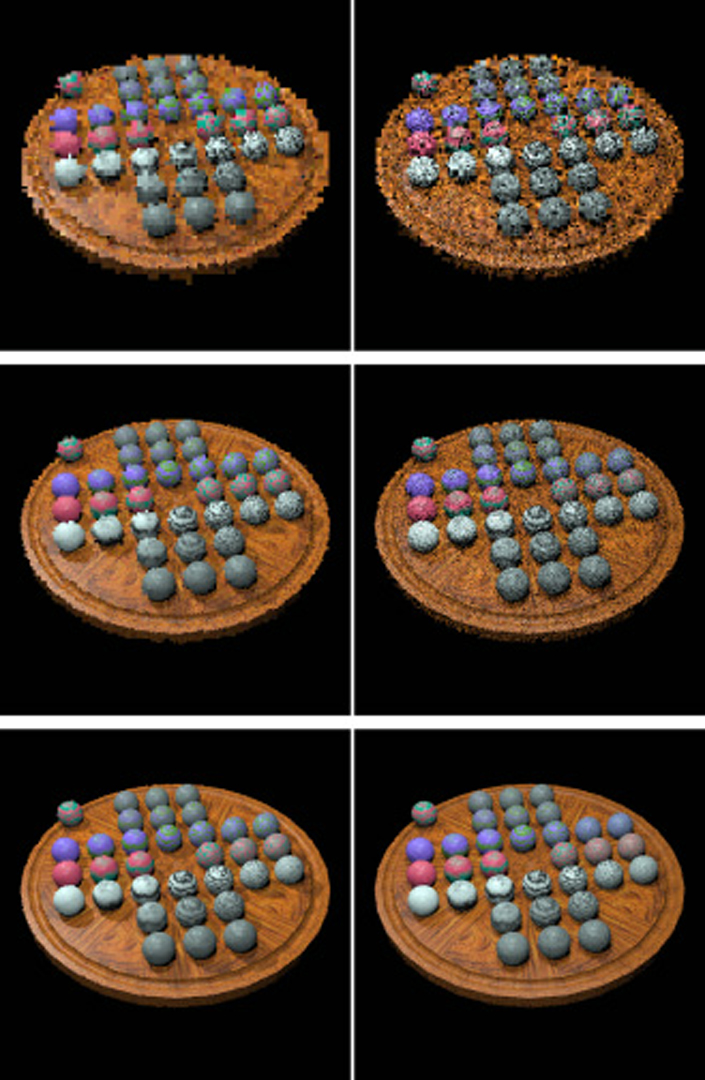“A perceptually based adaptive sampling algorithm” by Bolin and Meyer
Conference:
Type(s):
Title:
- A perceptually based adaptive sampling algorithm
Presenter(s)/Author(s):
Abstract:
A perceptually based approach for selecting image samples has been developed. An existing image processing vision model has been extended to handle color and has been simplified to run efficiently. The resulting new image quality model was inserted into an image synthesis program by first modifying the rendering algorithm so that it computed a wavelet representation. In addition to allowing image quality to be determined as the image was generated, the wavelet representation made it possible to use statistical information about the spatial frequency distribution of natural images to estimate values where samples were yet to be taken. Tests on the image synthesis algorithm showed that it correctly handled achromatic and chromatic spatial detail and that it was able predict and compensate for masking effects. The program was also shown to produce images of equivalent visual quality while using different rendering techniques.
References:
1. Barten, E G. J., “The Square Root Integral (SQRI): A New Metric to Describe the Effect of Various Display Parameters on Perceived Image Quality,” Human Vision, Visual Processing, and Digital Display, Proc. SPIE, Vol. 1077, pp. 73-82, 1989.
2. Bolin, M. R. and Meyer G. W., “A Frequency Based Ray Tracer,” Computer Graphics, Annual Conference Series, ACM SIG- GRAPH, pp. 409-418, 1995.
3. Bolin, M. R. and Meyer G. W., “An Error Metric for Monte Carlo Ray Tracing,” Rendering Techniques ’97, J. Dorsey and P. Slusallek, Editors, Springer-Verlag, New York, pp. 57-68, 1997.
4. Cohen, A., Daubechies, I., and Feauveau, J. C., “Biorthogonal Bases of Compactly Supported Wavelets,” Communications on Pure and Applied Mathematics, Vol. 45, No. 5, pp. 485-500, 1992.
5. Daly, S., “The Visible Differences Predictor: An Algorithm for the Assessment of Image Fidelity,” Digital Images and Human Vision, A. B. Watson, Editor, MIT Press, Cambridge, MA, pp. 179-206, 1993.
6. Daubechies, I., “Orthonormal Bases of Compactly Supported Wavelets,” Communications on Pure and Applied Mathematics, Vol. 41, No. 7, pp. 909-996, 1988.
7. Ferwerda, J. A., Shirley, E, Pattanaik, S. N., and Greenberg, D. E, “A Model of Visual Masking for Computer Graphics,” Computer Graphics, Annual Conference Series, ACM SIGGRAPH, pp. 143- 152, 1997.
8. Field, D. J., “Relations Between the Statistics of Natural Images and the Response Properties of Cortical Cells,” J. Opt. Soc. Am. A, Vol. 4, pp. 2379-2394, 1987.
9. Field, D. J., “What the Statistics of Natural Images Tell Us About Visual Coding,” Human Vision, Visual Processing, and Digital Display, Proc. SPIE, Vol. 1077, pp. 269-276, 1989.
10. Gibson, S. and Hubbold, R. J., “Perceptually-Driven Radiosity,” Computer Graphics Forum, Vol. 16, pp. 129-140, 1997.
11. Gortler, S. J., Grzeszczuk, R., Szeliski, R., and Cohen, M. E, “The Lumigraph,” Computer Graphics, Annual Conference Series, ACM SIGGRAPH, pp. 43-54, 1996.
12. Kirk, D. and Arvo, J., “Unbiased Sampling Techniques for Image Synthesis,” Computer Graphics, Annual Conference Series, ACM SIGGRAPH, pp. 153-156, 1991.
13. Lee, M. E., Redner, R. A., and Uselton, S. P., “Statistically Optimized Sampling for Distributed Ray Tracing,” Computer Graphics, Annual Conference Series, ACM SIGGRAPH, pp. 61-67, 1985.
14. Legge, G. E. and Foley, J. M., “Contrast Masking in human vision,” Journal of the Optical Society of America, Vol. 70, pp. 1458- 1470, 1980.
15. Li, B., “An Analysis and Comparison of Two Visual Discrimination Models,” Master’s Thesis, University of Oregon, June 1997.
16. Li, B., Meyer, G. W., and Klassen, R. V., “A Comparison of Two Image Quality Models,” to appear in Human Vision and Electronic Imaging III, B. E. Rogowitz and T. N. Pappas, Editors, Proc. SPIE, Vol. 3299, 1998.
17. Lubin, J., “A Visual Discrimination Model for Imaging System Design and Evaluation,” Vision Models for Target Detection and Recognition, Eli Peli, Editor, World Scientific, New Jersey, pp. 245- 283, 1995.
18. Maloney, L. T., “Evaluation of linear models of surface spectral reflectance with small numbers of parameters,” J. Opt. Soc. Am. A, Vol. 3, pp. 1673-1683. 1986.
19. Marimont, D. H. and Wandell, B. A., “Matching Color Images: The Impact of Axial Chromatic Aberration,” J. Opt. Soc. Am. A, Vol. 12, pp. 3113-3122, 1993.
20. Meyer, G. W. and Liu, A., “Color Spatial Acuity Control of a Screen Subdivision Image Synthesis Algorithm,” Human Vision, Visual Processing, and Digital Display III, Bernice E. Rogowitz, Editor, Proc. SPIE, Vol. 1666, pp. 387-399, 1992.
21. Mitchell, D. P., “Generating Antialiased Images at Low Sampling Densities,” Computer Graphics, Annual Conference Series, ACM SIGGRAPH, pp. 65-72, 1987.
22. Mullen, K. T., “The Contrast Sensitivity of Human Colour Vision to Red-Green and Blue-Yellow Chromatic Gratings,” J. Physiol. (Lond.), Vol. 359, pp. 381-400, 1985.
23. Painter, J. and Sloan, K. “Antialiased Ray Tracing by Adaptive Progressive Refinement,” Computer Graphics, Annual Conference Series, ACM SIGGRAPH, pp. 281-288, 1989.
24. Ruderman, D. L., “Origins of Scaling in Natural Images,” Human Vision, Visual Processing, and Digital Display, Proc. SPIE, Vol. 2657, pp. 120-131, 1996.
25. Rushmeier, H., Ward, G., Piatko, C., Sanders, P., and Rust, B., “Comparing Real and Synthetic Images: Some Ideas About Metrics,” Rendering Techniques ’95, P. M. Hanrahan and W. Purgathofer, Editors Springer-Verlag, New York, pp. 82-91, 1995.
26. Schreiber, W. F., Fundamentals of Electronic Imaging Systems, Springer-Verlag: Berlin Heidelberg, 1993.





